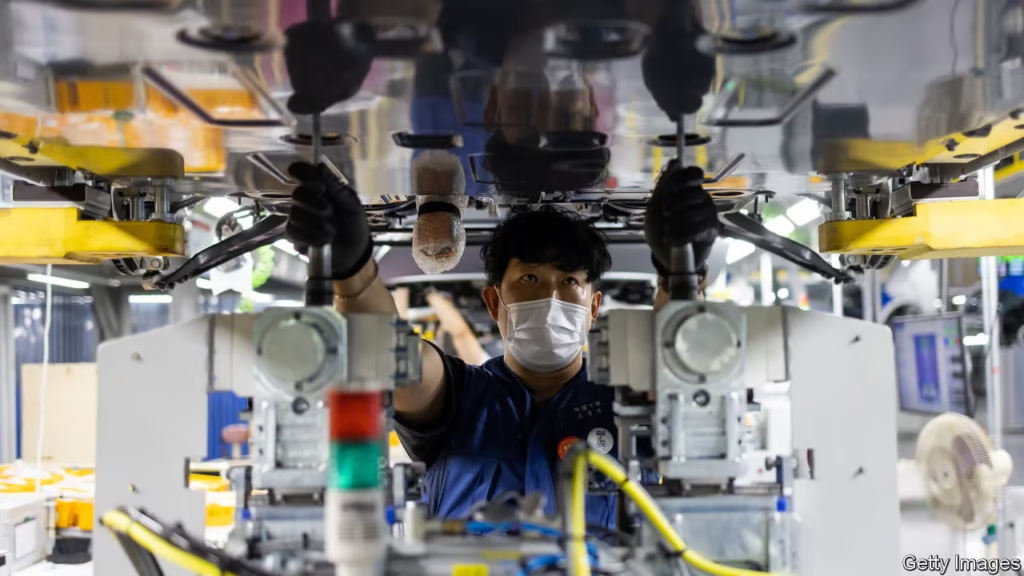In recent years, electric car sales worldwide have increased (25% increase in 2024 compared to the previous year). Automobile-producing countries, especially China, Germany, and the USA, are constantly announcing new investment and incentive decisions to avoid falling behind in this race (Chinese company CATL received 790 million dollars of support from the Chinese State in 2023). China is far ahead and continues advancing by widening the gap. In this field, where China, Germany, and the USA are mostly discussed, this article aims to think about South Korea and offer a perspective on the transformation of the automotive industry in our country.
Although electric cars have been on the world’s agenda recently, they were first produced in 1888 by German engineer Andreas Flocken. In 1900, one-third of the vehicles sold in the US were electric vehicles. However, due to the insufficient range of battery technology during that period (80 km on average) and charging problems, it lost its superiority over gasoline vehicles. Although there were many different initiatives from time to time, it was not until the early 2000s that electric cars became widespread again. The reason was the immaturity of lithium-ion battery technology and high costs.
In the US, General Motors produced electric cars with the EV1 model between 1996 and 1999, but only 1117 units were made due to high costs and low demand. Tesla, the second largest electric car manufacturer in the world today, was founded in 2003 and was able to offer the Tesla Roadster model, which can travel 320 km on a single charge, for sale in 2008 (for comparison, the price of the Roadstar in 2008 is $98,000, while the price of the Tesla Model Y in 2025 is $46,880). The biggest problem today, as it was then, is the high cost of the battery and the low range, which does not satisfy consumers (a 1 kWh battery pack cost $1000 in 2005, dropping to $115 in 2025).
On the Chinese side, BYD was founded in Shenzhen in 1995 to produce nickel-cadmium batteries, an older technology, not lithium batteries. It acquired Xi’an Qinchuan Automobile in 2003 and started gasoline vehicle production in 2005. In 2008, it launched its first rechargeable hybrid vehicle. It launched its first 100% electric vehicle in 2009. One of the key actors of that period was Wan Gang, who served as China’s Minister of Technology between 2007 and 2018. Wan, who rose to the position of technical manager at Audi after completing his doctorate in Germany, established a joint research center between the US and China in 2009 and is a visionary who knows the German automotive industry very well and who enabled China to focus on the production of electric cars instead of internal combustion vehicles to close the gap. In 2024, China will become the world’s largest automobile exporter (5.86 million cars). China was the world’s largest vehicle producer in 2010, producing 18 million vehicles. Still, it was technologically behind Japan and Germany (especially in internal combustion engine technology, chassis, quality control testing, and automation). Therefore, it waited patiently for Chinese technologies to mature (lithium-ion batteries, software, automation, and chips) that would resonate worldwide rather than starting exports immediately. Two milestone investments in this area are the acquisition of Swedish automobile manufacturer Volvo by Chinese company Geely in 2010 ($1.8 billion) and German robotic arm and automation manufacturer Kuka by Chinese white goods manufacturer Midea in 2016 ($4.1 billion). These and many other investments and acquisitions have contributed to the technological development of Chinese firms.
A historical comparison of the automobile industry between South Korea and Türkiye is described in an article co-published by Prof. Dr. Murat A. Yülek and South Korean researchers in 2020. In Türkiye, the American Ford Company opened a production facility in Istanbul in 1929, but it was closed in 1934 due to the Great Depression of 1929 and Türkiye’s closed economy model. Until 1950, governments focused on railroads, but after 1950, highway infrastructure investments were emphasized, and connections between cities were strengthened. Turkish Willys was licensed in 1954, Otokar in 1963, and BMC, Karsan, and bus production facilities were established in the following years. In the 1970s, Renault and Fiat opened production facilities. After 1980, Honda and Korean Hyundai invested in Türkiye. With economic liberalization in the 1980s, these policies were replaced by general export incentives and foreign investment liberalization. Since production is done through licensing, R&D investments in Türkiye have been significantly constrained by the licensing companies. As the Turkish automotive industry, export-oriented to Europe and integrated with Western companies, has not been able to adapt to the new wave of technology coming from China, Türkiye’s automotive production in 2024 declined by 7% year-on-year to 1,365,296 units by 2025. The share of imports in light commercial vehicles is 80 percent, and in automobiles it exceeds 70 percent. Electric car manufacturer TOGG sold 30 thousand 93 units of T10X in 2024.
South Korea ranks 5th in the world with an annual production of 4.5 million vehicles. South Korea went through similar periods and started output between 1960 and 1979 with the formation of the sector and the first license transfer. After 1990, it supported the sector with export incentives, and after 2000, with intensive R&D facilities and investments. In the article written by Yülek and his colleagues, they explain the difference between South Korea and Türkiye over the years with the following headings: a) South Korea has built globally competitive research and education institutions such as KAIST (World ranking 53rd), b) has supported entrepreneurs more by creating an ecosystem, c) has supported the formation of domestic producers instead of importing automobile parts, d) South Korea started exporting automobiles long before 1976, which made the sector competitive in the long run.
As of 2025, electric car transformation seems inevitable. Tesla Model Y Juniper received 50,000 orders in China within 24 hours, while Chinese mobile phone manufacturer Xiaomi’s 100% electric vehicle SU7 sold 130,000 units in 8 months. The most significant differences distinguishing electric cars from other internal combustion vehicles are battery technology, software, and electric motors. Countries notably advanced in battery and software technology are making a difference in this field.
The battery technology in electric cars has reached this level today thanks to consumer electronics devices. These are devices such as laptops, cell phones, and portable cameras. In the past, the first company to produce lithium-ion batteries was the Japanese Sony in 1991 because Sony needed an energy source for its portable devices. In the 1990s, the Japanese were the world leaders in this field (Sony, Panasonic, Sanyo, Murata, etc.). After 2000, South Korean companies such as Samsung, LG, and SK started to come to the fore in portable devices. As these companies advanced in consumer electronics, they naturally advanced in battery production. Similarly, Hyundai and Kia increased their sales figures during this period (Hyundai, which produced 1 million vehicles in 1995, produced 4.9 million cars in 2015). While Germany was ahead in internal combustion engine production, chassis, bodywork, and automation, it lagged in the battery and software industries. Naturally, Germany’s electric car industry was lagging. This explains VW’s decision to close factories in 2024. So why couldn’t South Korea, which is ahead in car production (Hyundai, Daewoo, and Kia) and batteries (LG, Samsung, SK innovation), develop electric cars like Tesla, BYD, or cell phone manufacturer Xiaomi?
A May 2024 report by Younkyoo Kim states that South Korea is highly dependent on China for battery production, with 96.6% of the cathode powder and 80.4% of the lithium hydroxide used in batteries from China. It is also stated that South Korea’s R&D investments remain at the level of patents and laboratories. In contrast, China can move to mass production rapidly, Korea is stricter than China in terms of environmental regulations, and most importantly, China can lower costs by taking advantage of economies of scale due to its population (China’s population is 1.4 billion, while South Korea’s is 51 million). South Korean Kia’s Ray and Hyundai Kona models use Chinese CATL batteries. South Korean manufacturers have shifted their production to China due to lower production costs at the time. Korea’s SK has a 40 GWh battery production facility in China (for comparison, Aspilsan’s Kayseri facility is 0.22 GWh, and Ankara Pomega Facility is 3 GWh). To prevent this dependency, LG plans to invest $5.2 billion and $10 billion in its nickel plant in Indonesia, Korea’s Posco $400 million, and automaker Hyundai $7.3 billion in electric vehicles shortly.
So what should Türkiye do next? As mentioned earlier, battery and software development seems to be essential. After the Chinese company BYD decided to invest in Manisa Turkiye, increasing the number of engineers and technical employees with incentives through the battery R&D center to be established would be beneficial. At the same time, it is recommended to support young entrepreneurs through incubation centers such as ITU Çekirdek, KOSGEB, and Tekmer and to make world-scale investments and incentives for localizing parts used in electric cars in Türkiye. Incentives should be provided for the domestic production of machinery and production lines to produce batteries. Training engineers and technical staff in an R&D center to be established jointly in Türkiye and China, providing scholarships to students in areas such as separators, liquid electrolytes (solid electrolyte in the future), conductive carbon, automation technologies, software, autonomous driving, etc. used in batteries will be beneficial for the survival of the Turkish automotive industry in the long term.
REFERENCES
https://www.oyakyatirim.com.tr/haberler/20250112122736/otomotiv-uretimi-2024-yilinda-7-geriledi
https://gazeteoksijen.com/yazarlar/emre-ozpeynirci/ithal-rekor-230938
State Capacity and the Role of Industrial Policy in Automobile Industry: a Comparative Analysis of Turkey and South Korea, https://doi.org/10.1007/s10842-019-00327-y
https://innovationreform.org/wp-content/uploads/2024/05/2024-05-Korea-Energy-EV-batteries.pdf
Abroad Africa AI Beijing Belt & Road BLCU BRICS China chinese CPC CSC Culture Deepseek Development Economy education Global Economics Kültür Langauge movie Russia scholarship science Shanghai Sino Sino Turkish Sino Turkish Sino Turkish Sino Turkish Sino Turkish Studies Sino Turkish Studies Sino Turkish Studies Sino Turkish Studies space Syria Taiwan Tariff trump Turkiye Türkiye University USA Xinjiang ZJUT Çin





